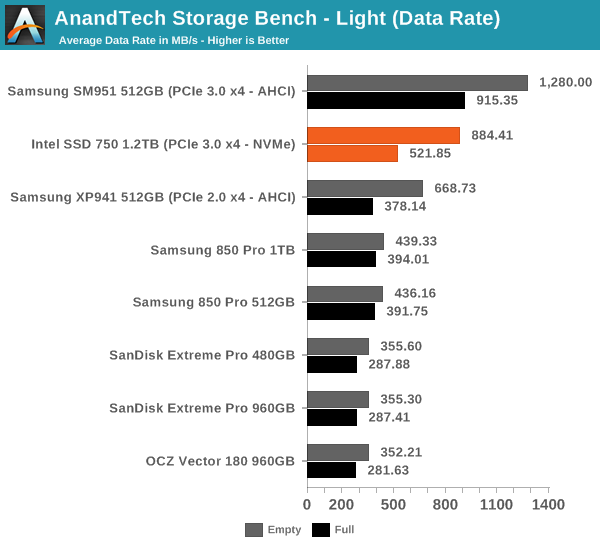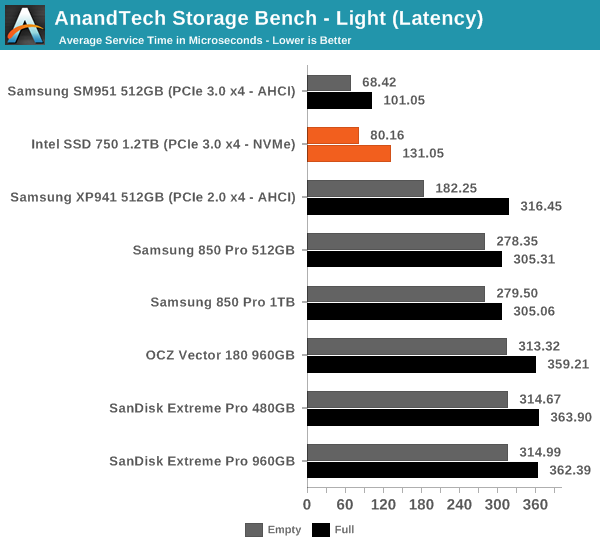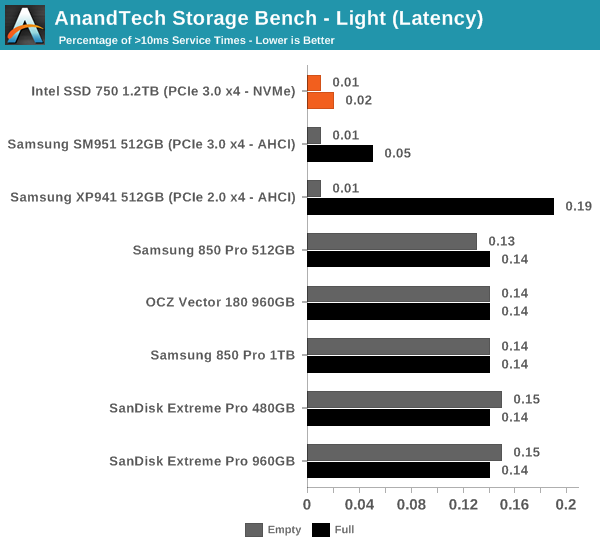Intel SSD 750 PCIe SSD Review: NVMe for the Client
by Kristian Vättö on April 2, 2015 12:00 PM ESTAnandTech Storage Bench - Light
The Light trace is designed to be an accurate illustration of basic usage. It's basically a subset of the Heavy trace, but we've left out some workloads to reduce the writes and make it more read intensive in general.
| AnandTech Storage Bench - Light - Specs | ||||||||||||
| Reads | 372,630 | |||||||||||
| Writes | 459,709 | |||||||||||
| Total IO Operations | 832,339 | |||||||||||
| Total GB Read | 17.97 GB | |||||||||||
| Total GB Written | 23.25 GB | |||||||||||
| Average Queue Depth | ~4.6 | |||||||||||
| Focus | Basic, light IO usage | |||||||||||
The Light trace still has more writes than reads, but a very light workload would be even more read-centric (think web browsing, document editing, etc). It has about 23GB of writes, which would account for roughly two or three days of average usage (i.e. 7-11GB per day).
| AnandTech Storage Bench - Light - IO Breakdown | |||||||||||
| IO Size | <4KB | 4KB | 8KB | 16KB | 32KB | 64KB | 128KB | ||||
| % of Total | 6.2% | 27.6% | 2.4% | 8.0% | 6.5% | 4.8% | 26.4% | ||||
The IO distribution of the Light trace is very similar to the Heavy trace with slightly more IOs being 128KB. About 70% of the IOs are sequential, though, so that is a major difference compared to the Heavy trace.
| AnandTech Storage Bench - Light - QD Breakdown | ||||||||||||
| Queue Depth | 1 | 2 | 3 | 4-5 | 6-10 | 11-20 | 21-32 | >32 | ||||
| % of Total | 73.4% | 16.8% | 2.6% | 2.3% | 3.1% | 1.5% | 0.2% | 0.2% | ||||
Over 90% of the IOs have a queue depth of one or two, which further proves the importance of low queue depth performance.

The same trend continues in our Light trace where the SM951 is still the king of the hill. It's obvious that Intel didn't design the SSD 750 with such light workloads in mind as ultimately you need to have a relatively IO intensive workload to get the full benefit of PCIe and NVMe.












132 Comments
View All Comments
mmrezaie - Thursday, April 2, 2015 - link
finally it has started, although I wont budge now. maybe next generation.blanarahul - Thursday, April 2, 2015 - link
Hey Kristian, I read that the 1.2 TB model uses 84 dies. But that's not a multiple of 18. So what gives? Is it running in 14 channel mode or something?blanarahul - Thursday, April 2, 2015 - link
Okay so it has 86 dies. But now it's even more confusing. Aren't they supposed be multiples of number of channels the controller is using?SunLord - Thursday, April 2, 2015 - link
Its likely 18 channels so 4 probably only address 4 dies while the 14 other channels handle 5woggs - Thursday, April 2, 2015 - link
yepTyrDonar - Friday, April 10, 2015 - link
Controllers don't have to operate on a specific multiple of the number of dies. That's just a coincidence as to how we've seen them so far on most SSD's. They can operate with varying priorities and asymmetrically. Further, more than 1 channel can address the same die in different intervals/priorities. As controllers become more and more complex, this kind of assymetrical operation will become more common, unfortunately this is correlated with increasing number of total dies and lower reliability.huaxshin - Thursday, April 2, 2015 - link
Will there be any M2 SSDs from Intel with NVMe? Some notebooks, and desktops, have routed PCIe to M2 slots where its the only place its available.blanarahul - Thursday, April 2, 2015 - link
No.DigitalFreak - Thursday, April 2, 2015 - link
Not with this controller. Maybe down the road.bgelfand - Thursday, April 2, 2015 - link
I suspect this drive is not for the current z97 chip set, but will realize its potential with the Z170 chipset (Sunrise Point) due for release in the second half of this year with Skylake. The Z170 chipset has 20 PCIe 3.0 lanes and DMI 3.0 (8 GB/s) bus interface.It should be a very interesting second half of the year - Skylake CPU, Sunrise Point chipsets, and Windows 10.